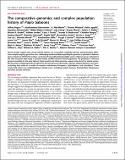The comparative genomics and complex population history of Papio baboons
Abstract
Recent studies suggest that closely related species can accumulate substantial genetic and phenotypic differences despite ongoing gene flow, thus challenging traditional ideas regarding the genetics of speciation. Baboons (genus Papio) are Old World monkeys consisting of six readily distinguishable species. Baboon species hybridize in the wild, and prior data imply a complex history of differentiation and introgression. We produced a reference genome assembly for the olive baboon (Papio anubis) and whole-genome sequence data for all six extant species. We document multiple episodes of admixture and introgression during the radiation of Papio baboons, thus demonstrating their value as a model of complex evolutionary divergence, hybridization, and reticulation. These results help inform our understanding of similar cases, including modern humans, Neanderthals, Denisovans, and other ancient hominins.
Citation
Rogers , J , Raveendran , M , Harris , R A , Mailund , T , Leppälä , K , Athanasiadis , G , Schierup , M H , Cheng , J , Munch , K , Walker , J A , Konkel , M K , Jordan , V , Steely , C J , Beckstrom , T O , Bergey , C , Burrell , A , Schrempf , D , Noll , A , Kothe , M , Kopp , G H , Liu , Y , Murali , S , Billis , K , Martin , F J , Muffato , M , Cox , L , Else , J , Disotell , T , Muzny , D M , Phillips-conroy , J , Aken , B , Eichler , E E , Marques-bonet , T , Kosiol , C , Batzer , M A , Hahn , M W , Tung , J , Zinner , D , Roos , C , Jolly , C J , Gibbs , R A & Worley , K C 2019 , ' The comparative genomics and complex population history of Papio baboons ' , Science Advances , vol. 5 , no. 1 , eaau6947 . https://doi.org/10.1126/sciadv.aau6947
Publication
Science Advances
Status
Peer reviewed
ISSN
2375-2548Type
Journal article
Description
The sequencing and analysis activities at the Human Genome Sequencing Center, Baylor College of Medicine, were supported by NIH (NHGRI) grants U54-HG003273 and U54-HG006484 to R.A.G. and GAC grant 1 S10 RR026605 to J. G. Reid. This research was also supported by NIH grant R01-GM59290 to M.A.B.; grants from the Austrian Science Fund (FWF-P24551 and FWF-W1225) and Vienna Science and Technology Fund (WWTF-MA16-061) to C.K.; grants from the Wellcome Trust (WT108749/Z/15/Z) and EMBL to B.A., F.J.M., and M.M.; grants VEGA 1/0719/14 and APVV-14-0253 to T. Vinar (Consortium Member); MINECO/FEDER grant, NIH U01-MH106874 grant, Howard Hughes International Early Career award, and Obra Social “La Caixa” award to T.M.-B.; NSF grants BNS83-03506 to J.P.-C.; NSF1029302 to J.P.-C., J.R., and C.J.J.; BNS96-15150 to J.P.-C., C.J.J., and T.D.; and National Geographic Society and Leakey Foundation grants to J.P.-C. and C.J.J. E.E.E. is an investigator of the Howard Hughes Medical Institute. This work was supported, in part, by U.S. NIH grant HG002385 to E.E.E.Collections
Items in the St Andrews Research Repository are protected by copyright, with all rights reserved, unless otherwise indicated.

